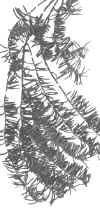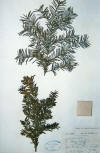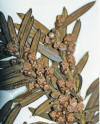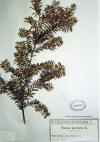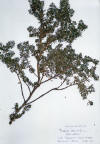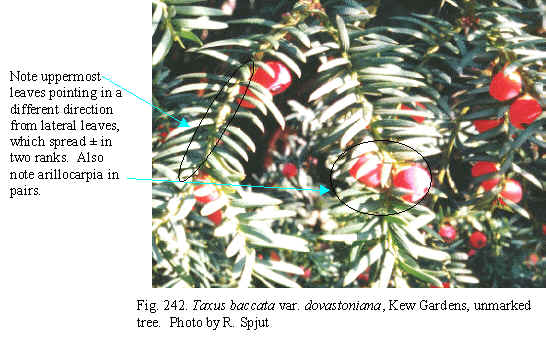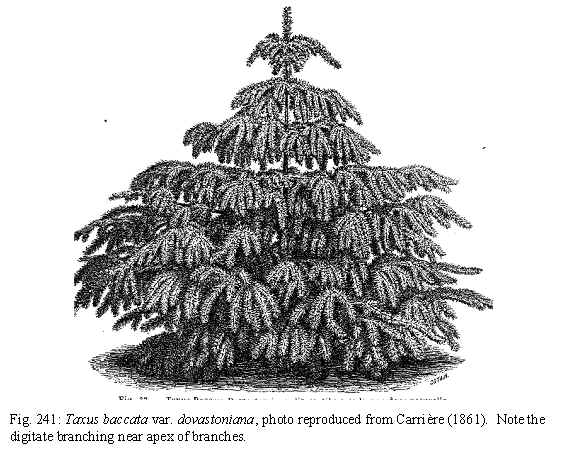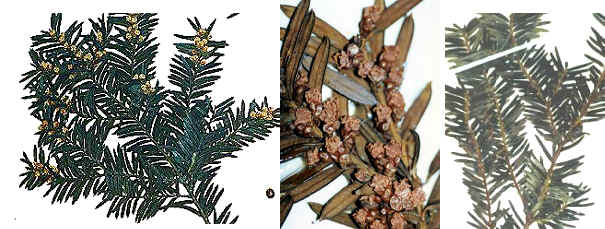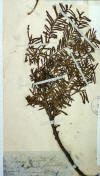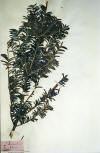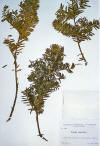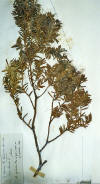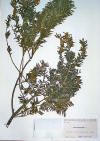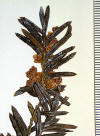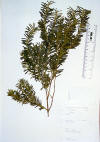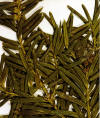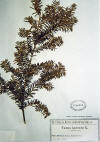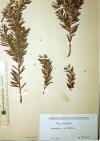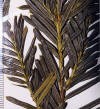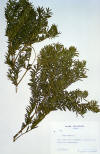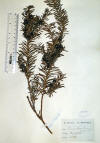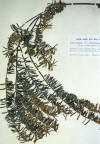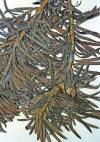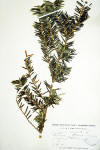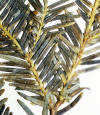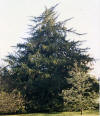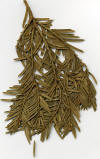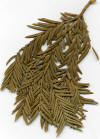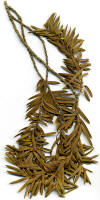1b. Taxus
baccata var. dovastoniana Leighton, Fl. Shropshire 497. Taxus communis var. epacroides J. Nelson, Pinaceae 172 (1866), proposed taxonomic synonym. T. baccata epacrioides (J. Nels.) R. Smith 41 (1874). Taxus baccata [f.] epacroides hort. ex Beissner, Hand. Nadelh. 175 (1891). Taxus baccata var. epacridioides (J. Nels.) Bailey, Cult. Conif. N. Amer. 22 (1933); T. baccata f. epacrioides Pilger, Pflanzenreich 18(iv, 5): 115 (1903). Known from cultivated material in England (Krüssmann 1985). Origin unknown. Original material unknown. Neotype proposed: England. Bristol, Birdham Down, Roper 1525, lower specimen on sheet with 2 specimens (K!), with 9 stomata rows/band, abaxial margin of 4 smooth cells.
Dovaston yew. Distribution: Widely distributed in the Euro-Mediterranean; cultivated in Europe and in the U.S. Pyramidal tree with horizontal to ascending branches bearing long pendulous branchlets in typical plants, or in plants appearing nearly pinnate to nearly fastigiate; bole to “5 ft and 1 in” in circumference, the crown reaching “56 ft” in diam.; branchlets pale orange, or somewhat glaucous in part; persistent bud scales loosely attached, turgid, ovate, concave, obtuse, yellowish to reddish brown; leaves caesious or dark green to pale green when dried on adaxial surface, green or orange on abaxial surface, not as yellowish as in var. glauca, slightly overlapping, wide spreading, recurved, partly radial, the uppermost crisscrossing when pressed, more secund towards base of branchlets, nearly oblong, rounded along margins in transverse sections; males and female cones in globular aggregates on young branchlets, usually dioecious; seed globose, reddish brown. The Dovaston yew is distinguished by relatively long, pendulous, undivided branchlets that spread almost digitately from near the apex of a horizontal branch as evident in original material of that plant (Loudon's 1844 illustration, specimens from original tree), and by the leaves that appear dark green and spread partly in two ranks—those that seem to arise along the horizontal and lower parts of branchlets—in contrast to the uppermost leaves on a branchlet that bend upwards. However, in other specimens, branchlets are not all that long and show a subpinnate to subfastigiate arrangement, which, nevertheless, are considered var. dovastoniana by the flexuous appearance of the branchlets that would seem to have been pendulous when collected, by the leaves that have a dark green color and shape between oblong and linear (due to their relatively short length), and by having the same leaf arrangement as in the type (leaves spreading partly along two sides in one plane except for the uppermost leaves that point upwards). These specimens correspond to var. epacroides based on a specimen from Baenitz (US). Another specimen, referred to as Cv. ‘Brevifolia’ from a cultivated plant at "Wakehurst Place", is assigned to var. dovastoniana even though it is a likely hybrid between naturally occurring T. canadensis var. adpressa and T. baccata var. dovastoniana. The female cones of the Dovaston yew develop near ends of branchlets that apparently have terminated their growth, and the mature arillocarpia seem to occur in pairs as noted by Leighton (1841); however, paired arillocarpia also occur in T. baccata var. glauca, and in T. recurvata. The weeping branchlets that seem characteristic of the typical Dovaston yew, however, are also found in the cultivated T. cuspidata, which is native to Japan.
Taxus baccata var. glauca can be difficult to distinguish from var. dovastoniana. It differs slightly in having a stronger yellowish color in dried specimens, especially the younger leaves, and by the leaves that overlap more closely in a parallel arrangement in spreading outwards in a horizontal plane along two sides of a branchlet, or in curving upwards. Specimens of the Dovaston yew from the southwestern Mediterranean region have paler green leaves with an intermediate phyllotaxy to var. glauca. These plants might be referred to var. pendula, which in horticulture has been recognized by a long drooping leader (Callen 1977), a feature occurs in other species such as T. recurvata, while T baccata var. glauca can also have pendulous branchlets. Additionally, in many specimens of var. glauca, the branchlets are recurved.
Carrière (1867) reported the Dovaston yew to be native to N China and Japan, and introduced to Europe, but according to Loudon (1844), the Dovaston yew originated from a plant obtained by John Dovaston as a seedling or small tree from a hedge bank near Sutton. Loudon (1844) further indicated that Dovaston, after purchasing this yew from a farmer in 1777, reportedly transplanted it to prevent soil from falling into his well in Westfelton. The transplanted yew developed a crown diam. of 56 ft and bole circumference of 5 ft in 50 years (1837), and by 1900 had reached 8 ft 10" (Elwes & Henry 1906). Although predominantly male, one branch produced seed as evidenced by a specimen from Bidwell (BM). Plants grown from seeds of this branch developed either “the habit of the parent,” except for the occurrence of female trees, or that of the “common yew” (Elwes & Henry 1906). The leaf anatomical features of the Dovaston yew indicate a European origin. Leaves studied from three specimens taken from the original tree have midrib papillae positioned medially on epidermal cells. Most species have papillae positioned off-center (submedial), or near the cell wall (submarginal). The medial position of scattered papillae on epidermal cells is a feature that appears on many specimens from the British Isles and one specimen from the Caucasus Mountains. Additionally, the abaxial leaf margin is frequently differentiated by several or more rows of short epidermal cells that are usually followed by many rows of longer papillose cells, and the leaf mesophyll was noted to have dark spherical cells (idioblasts). These character features indicate affinity to Taxus contorta. A specimen of the Dovaston yew from the Caucasus Mountains (Fig. 245) differs from European plants in the abaxial leaf surface lacking papillae across a broad marginal region—14 cells across, and in having 11 stomata rows per band. However, there are many other exceptions to leaf anatomical features of the Baccata Alliance in the Caucasia and Transcaucasia regions. Thus, the Dovaston yew may be just another example of a naturally occurring variety that has acquired various characteristics through hybridization and introgression with other taxa. This would also include the European T. recurvata. Elwes and Henry (1906) noted “a curious pendulous habit” in one of the “indigenous trees” “at Secley Wood, on the Severn”, and that the leaves of “var. recurvata resemble those of the Dovaston yew.”
A photo of a yew cultivated on Madeira similar to the specimen shown above in Fig. 243 can be seen at http://jardin-mundani.es/taxaceae/teix-mascle1.jpg. Representative Specimens—Morocco: Ifrane, 1400 m, tree in humid forest, Lewalle 9670 (BM); Ifrane, 1600 m, Lewalle 12378 (BM). Spain: Barcelona, pare de la Bonanova, Sennen 7087 (BM, not PH); Burgos, Sierra Obarenes, 1000 m, H. Elias 4353 (BM). Portugal: Madeira, Pico du Gala, in forest, 1000 m, Oct. 1865, Meaden (K). England: Leicestershire, Winscombe Churchyard, 1841, Deuaes (PH) ); Kent Ap. ys 77-390 (K). Finland: without additional locality data, yr 1909, Florstöm (K). Poland: Silesia, Breslau, 120 m, f. epacroides (US). Macedonia: Petiska, Kosarim (S: C-2065). Greece: Artis, Mt. Tzoumerka, Georgiadis & Tzanoudakis 631 (BM). Russia—Caucasus Mts.: Terek Prov., Busch (K). Cultivation— England: in adnot. “T. baccata L. ‘brevifolia,’” Hunt 1524 (K).
|
